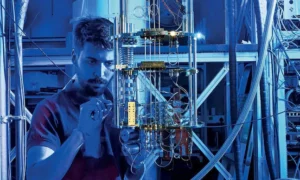In the ever-evolving landscape of technology, quantum computing stands as a beacon of promise, offering unprecedented computational power and the potential to reshape the way we solve complex problems. As we delve into the current status quo of quantum computing, it becomes evident that the journey is marked by both remarkable progress and intriguing limitations.
The Quantum Leap: Progress in Quantum Computing
- Quantum Supremacy
The year 2019 witnessed a historic moment in the realm of quantum computing with Google’s claim of achieving quantum supremacy. The quantum processor, named Sycamore, demonstrated the ability to perform a specific calculation faster than the most advanced classical supercomputers. This breakthrough ignited a surge of interest and investments in quantum technologies, pushing the boundaries of what was previously thought possible.
- Commercialization of Quantum Technologies
Beyond the confines of research labs, quantum computing is making its way into the commercial domain. Major players such as IBM, Microsoft, and startups like Rigetti Computing are investing heavily in developing quantum hardware and software. Cloud-based quantum computing platforms are emerging, allowing businesses and researchers to access quantum resources remotely, democratizing the quantum computing experience.
- Quantum Algorithms
While quantum supremacy showcased the raw computational power of quantum processors, the true potential lies in their ability to solve real-world problems efficiently. Quantum algorithms, such as Shor’s algorithm for factoring large numbers and Grover’s algorithm for unstructured search, are advancing. Researchers are exploring applications in cryptography, optimization, and machine learning, promising transformative solutions across diverse industries.
- Entanglement and Superposition
Fundamental quantum principles like entanglement and superposition are at the heart of quantum computing’s power. Researchers are exploring ways to harness and manipulate these phenomena to create more stable and error-resistant qubits, the basic units of quantum information. Advancements in error correction codes and fault-tolerant quantum computing are mitigating the challenges posed by the delicate nature of quantum states.
Materials Science and Quantum Hardware Innovations
Quantum hardware development is progressing rapidly, with a focus on building more robust and scalable quantum processors. Superconducting qubits, trapped ions, and topological qubits are among the leading contenders. Materials science plays a pivotal role in designing qubits with longer coherence times, enabling more intricate computations. Quantum hardware innovations are crucial for transitioning from proof-of-concept experiments to practical and scalable quantum computers.
Limitations on the Quantum Horizon
- Decoherence and Error Rates: The Achilles’ Heel
Quantum systems are exceptionally delicate, and maintaining the coherence of qubits is a persistent challenge. Decoherence, caused by interactions with the external environment, limits the duration of quantum computations. High error rates in quantum gates and operations pose additional hurdles, necessitating advancements in error correction techniques. Overcoming these challenges is paramount for achieving reliable and scalable quantum computing.
- Scalability: Bridging the Quantum Chasm
While quantum computers have demonstrated their prowess in specific tasks, achieving scalability remains a formidable obstacle. As the number of qubits increases, so does the complexity of managing quantum coherence and minimizing errors. Researchers are exploring various architectures and connectivity options to build larger, more interconnected quantum systems that can handle complex computations across diverse domains.
- Quantum Software and Algorithmic Maturity
The development of quantum software lags behind hardware advancements, posing a bottleneck in harnessing the full potential of quantum computers. Creating efficient algorithms for practical applications and optimizing existing ones is a complex task. As the quantum programming ecosystem evolves, a crucial balance must be struck between algorithmic sophistication and the limitations imposed by current quantum hardware.
- Quantum Communication Challenges
While the focus of quantum computing often revolves around local computation, the broader implications extend into the realm of quantum communication. Quantum communication holds the key to secure data transmission, a critical aspect in an era where cybersecurity is of paramount importance. Quantum key distribution (QKD) protocols, which leverage the principles of quantum mechanics for secure communication, represent a significant stride toward quantum-safe encryption.
However, the implementation of quantum communication networks faces formidable challenges. One of the primary obstacles is the development of reliable quantum repeaters. In classical communication, signal repeaters amplify and retransmit signals to overcome losses in transmission. In the quantum realm, the process is more intricate due to the no-cloning theorem, which states that an arbitrary unknown quantum state cannot be copied perfectly. Quantum repeaters must operate without compromising the delicate quantum states being transmitted, demanding innovations in quantum error correction and the creation of entangled states over long distances.
Additionally, mitigating losses in quantum communication channels remains a hurdle. Quantum states are highly susceptible to decoherence and environmental interactions during transmission. As quantum signals traverse fiber-optic cables or free space, losses occur, and maintaining the integrity of quantum information becomes increasingly challenging. Researchers are exploring techniques such as quantum error correction and advanced quantum communication protocols to address these issues and pave the way for the practical implementation of quantum communication on a global scale.
Policy and Ethical Considerations in Quantum Computing
As quantum computing progresses, policymakers and ethicists are faced with unique challenges. Quantum technologies, particularly in the context of cryptography, raise questions about the implications for national security and privacy. The advent of powerful quantum algorithms, such as Shor’s algorithm, which can efficiently factor large numbers, has the potential to compromise widely-used cryptographic protocols.
In response, researchers and policymakers are actively exploring quantum-safe cryptographic solutions, often referred to as post-quantum cryptography. Transitioning to these new cryptographic standards requires careful planning and coordination to ensure the security of digital communication systems. Moreover, the global nature of the internet necessitates international collaboration to establish standards that can withstand the advent of quantum computers capable of breaking existing cryptographic schemes.
Ethical considerations also come to the forefront as quantum computing progresses. Issues related to data privacy, the potential for misuse of quantum capabilities, and the ethical implications of quantum technologies in fields like artificial intelligence and machine learning require thoughtful examination. Establishing ethical frameworks and guidelines for the responsible development and deployment of quantum technologies is an ongoing conversation that involves not only scientists and engineers but also policymakers, ethicists, and the broader public.
Environmental Impact and Energy Consumption
The quest for ever more powerful computing technologies, including quantum computing, raises concerns about the environmental impact and energy consumption associated with these advancements. Quantum computers, particularly those based on superconducting qubits, require extremely low temperatures to operate. The cooling infrastructure necessary for maintaining these temperatures can be energy-intensive.
Furthermore, the development and production of quantum hardware involve complex manufacturing processes that may have environmental consequences. As the demand for quantum computing resources grows, there is a need to explore sustainable approaches in the design and operation of quantum computers. Research efforts are underway to optimize quantum algorithms for energy efficiency and explore alternative quantum computing architectures that may have a reduced environmental footprint.
Conclusion
The status quo of quantum computing is a dynamic interplay between groundbreaking progress and persistent limitations. As quantum technologies mature, the path forward for quantum computing involves collaborative efforts from researchers, engineers, and businesses. Overcoming the challenges posed by decoherence, error rates, scalability, and algorithmic maturity requires a multidisciplinary approach. The journey toward practical quantum computing is an unfolding narrative, and the chapters yet to be written hold the promise of transformative advancements. The status quo is one of optimism, tempered by the recognition of the formidable obstacles that lie ahead. Quantum computing’s potential to revolutionize industries, solve complex problems, and usher in a new era of computation is within reach, provided we navigate the quantum frontier with diligence and innovation.



































